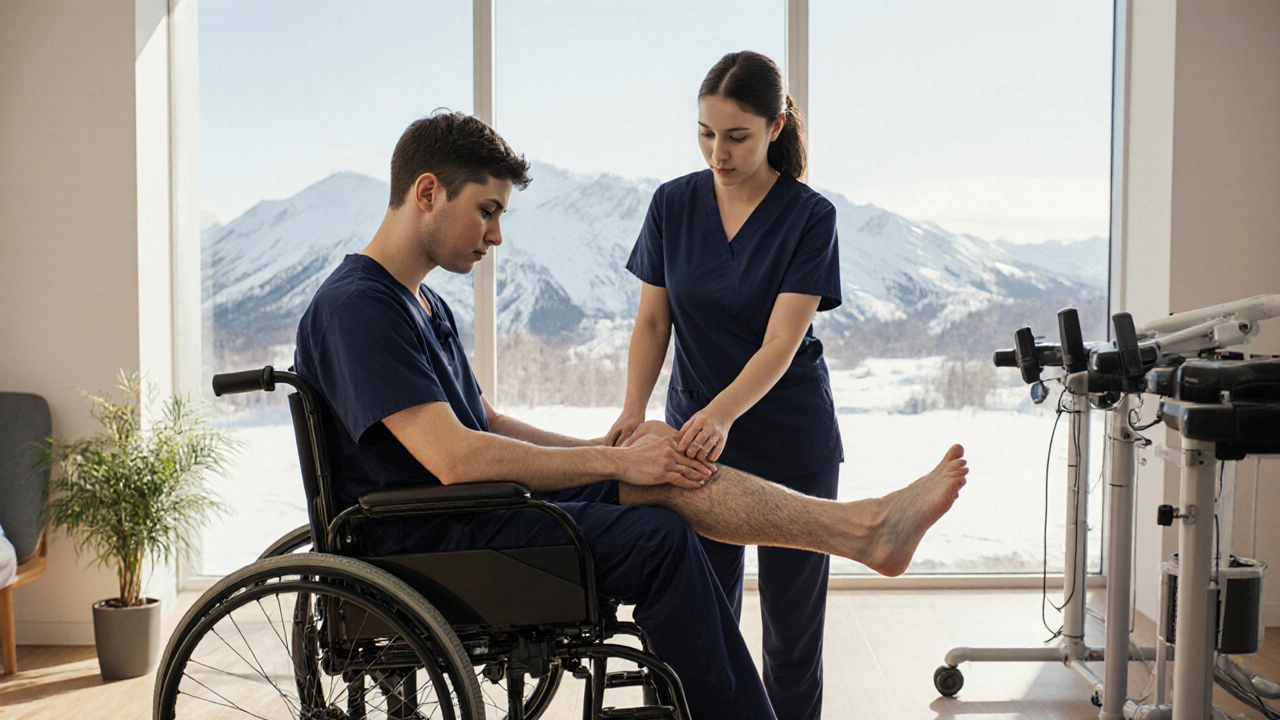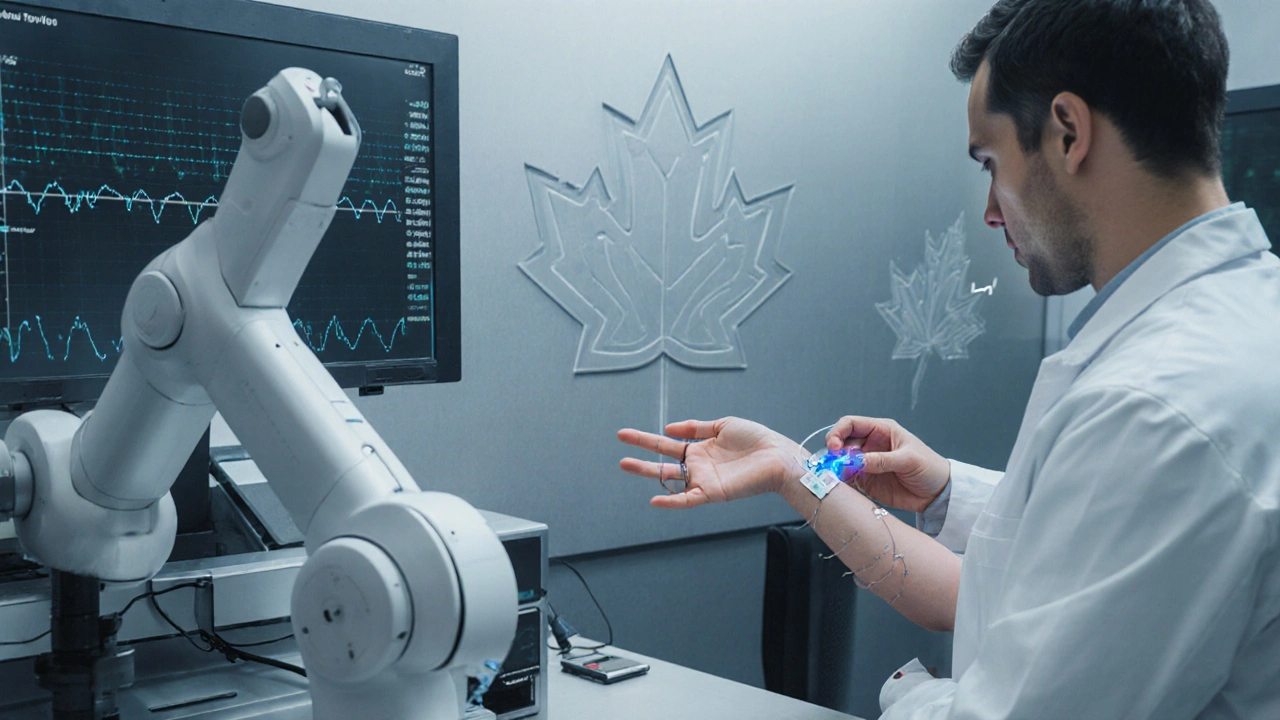How Spasticity Links to Spinal Cord Injuries and What You Can Do About It
 Sep, 26 2025
Sep, 26 2025
When a spinal cord injury (SCI) occurs, the body’s wiring gets scrambled. One of the most frustrating side‑effects is spasticity - a sudden, involuntary tightening of muscles that can turn everyday movements into a battle. This article untangles why spastic muscle states appear after SCI, how clinicians measure them, and which interventions actually work.
What is Spasticity?
Spasticity is a velocity‑dependent increase in muscle tone caused by disruption of upper motor neuron pathways. It often shows up as jerky reflexes, clonus, or a feeling of stiffness that worsens with rapid movement. Unlike simple muscle tightness, spasticity is rooted in the central nervous system’s loss of inhibitory control.
Why Does Spinal Cord Injury Trigger Spasticity?
SCI damages the descending tracts that normally keep muscle activity in check. The key player is the Upper Motor Neuron (UMN) Lesion - a disruption of pathways originating in the brain and traveling down the spinal cord. When these signals are blocked, lower motor neurons become over‑excitable, leading to the exaggerated stretch reflexes that define spasticity.
Research from the National Institute of Neurological Disorders (2022) shows that up to 80% of people with incomplete SCI develop clinically significant spasticity within the first year. The severity often mirrors the level and completeness of the injury - higher injuries (cervical) tend to produce more widespread tone changes.
How Is Spasticity Measured?
Clinicians rely on standardized tools to quantify tone and guide treatment. The most widely used is the Modified Ashworth Scale (MAS), which grades resistance during passive movement from 0 (no increase) to 4 (rigid). Although the MAS is quick, it has limited sensitivity for small changes.
For research or detailed tracking, the Tardieu Scale adds velocity parameters, offering a more nuanced picture of spasticity versus contracture. Both scales feed into the American Spinal Injury Association (ASIA) Impairment Scale, which classifies overall injury severity and predicts functional outcomes.
Treatment Landscape: Comparing the Options
Managing spasticity is a balancing act between reducing unwanted tone and preserving enough reflex activity for functional tasks like ambulation or bladder control. Below is a quick comparison of the most common approaches.
| Treatment | Mechanism | Onset | Duration | Typical Use | Common Side Effects |
|---|---|---|---|---|---|
| Oral Baclofen | GABA‑B agonist; reduces spinal reflex excitability | 1‑2hours | 6‑12hours (multiple doses) | Mild‑to‑moderate generalized spasticity | Drowsiness, dizziness, weakness |
| Botulinum Toxin (Botox) | Blocks acetylcholine release at the neuromuscular junction | 3‑7days | 3‑4months | Focal spasticity (e.g., calf, biceps) | Local weakness, injection pain |
| Physical Therapy | Stretching, strengthening, neuro‑re‑education | Immediate (during session) | Variable, benefits accrue over weeks | All levels of spasticity | Muscle soreness, fatigue |
| Functional Electrical Stimulation (FES) | Electrical pulses stimulate antagonist muscles | Minutes | During use; lasting effects after regular training | Lower‑limb gait assistance | Skin irritation, discomfort |
Choosing the right mix depends on the spasticity pattern (focal vs. generalized), the patient’s goals, and any comorbidities. Often clinicians start with oral medication for broad control, add Botox for stubborn focal bursts, and layer on therapy to maintain range of motion.
Physical Therapy: The Core of Rehabilitation
Even the most potent drug won’t fix contractures that have already formed. That’s where Physical therapy steps in. Key components include:
- Daily passive and active stretching to keep muscles pliable.
- Strengthening antagonist groups to create a push‑pull balance.
- Task‑specific gait training, often using Functional Electrical Stimulation (FES) devices to cue muscle activation.
- Positioning strategies (e.g., night splints) to prevent joint deformities.
Studies from the International Journal of Rehabilitation (2023) demonstrate that a 12‑week intensive PT program can lower MAS scores by an average of 1.2 grades, translating into measurable gains in walking speed and independence.

Pharmacologic Options: When Meds Matter
Baclofen remains the first‑line oral drug because it crosses the blood‑brain barrier and directly dampens hyperactive spinal neurons. The typical starting dose is 5mg three times daily, titrated up to 80mg per day as tolerated.
For refractory cases, intrathecal baclofen pumps deliver the medication directly into the cerebrospinal fluid, achieving higher spinal concentrations with fewer systemic side effects. A 2021 multicenter trial reported a 70% reduction in severe spasticity episodes after pump implantation.
Injectable Botulinum toxin is ideal for focal over‑activity, such as calf muscle spasm that hampers foot clearance. Doses are weight‑adjusted (typically 4‑6U/kg per muscle) and require repeat injections every 3-4months.
Impact on Daily Life and Long‑Term Outlook
Uncontrolled spasticity can cascade into secondary complications: pressure ulcers from reduced mobility, chronic pain, and even respiratory issues if chest wall muscles tighten. Conversely, appropriately managed tone can aid functional tasks - a mild increase in plantar flexor tone can improve push‑off during walking.
Quality‑of‑life scores (SF‑36) improve by an average of 12 points when patients achieve a MAS reduction of at least one grade, underscoring the tangible benefits of diligent management.
Emerging Research and Future Directions
Neuroscientists are exploring neuromodulation techniques like transcranial magnetic stimulation (TMS) to re‑establish inhibitory pathways. Early pilot data suggest a 30% reduction in spasticity after a 2‑week TMS course.
Another promising avenue is stem‑cell grafting aimed at rebuilding damaged corticospinal tracts. While still experimental, animal models show restored reflex balance and reduced spastic tone.
For patients and clinicians, staying aware of these advances is crucial - they may soon expand the toolbox beyond drugs and exercises.
Practical Checklist for Managing Spasticity after SCI
- Document baseline tone using the Modified Ashworth Scale and note functional impact.
- Start oral baclofen at low dose; monitor for drowsiness.
- Schedule regular stretching sessions (minimum 10minutes per major muscle group, twice daily).
- Consider focal Botox for stubborn muscle groups after 4-6weeks of pharmacotherapy.
- Incorporate functional electrical stimulation during gait training if walking is a goal.
- Review contracture risk monthly; adjust splinting or positioning as needed.
- Re‑evaluate tone every 3months; adjust treatment mix based on MAS changes and patient goals.
Related Concepts and Next Steps
Understanding spasticity sits within a broader Neurorehabilitation framework that includes mobility aids, bladder management, and psychosocial support. Readers interested in the bigger picture might explore:
- “Assistive Technology for SCI” - how wheelchairs and exoskeletons complement tone management.
- “Pain Management after Spinal Cord Injury” - interplay between spasticity and neuropathic pain.
- “Community Reintegration Strategies” - addressing social barriers for people living with SCI.

Frequently Asked Questions
What triggers a sudden increase in spasticity after an injury?
Acute changes like infection, urinary blockage, or even high‑stress situations can heighten reflex excitability. Managing triggers-through bladder care, skin monitoring, and stress reduction-helps keep tone stable.
Is it safe to combine baclofen with Botox?
Yes, many clinicians use both. Baclofen addresses overall tone while Botox targets stubborn focal spots. The key is to start each treatment at low doses and monitor for excessive weakness.
Can spasticity ever be a good thing?
Mild spasticity can aid standing or walking by providing extra push‑off power. The goal isn’t to eliminate tone entirely but to balance it so it supports, not hinders, functional tasks.
How often should I be reassessed for spasticity?
A baseline assessment is essential within the first month post‑injury. After that, schedule formal MAS or Tardieu checks every 8‑12weeks, or sooner if a new symptom emerges.
What lifestyle changes can reduce spasticity?
Staying hydrated, maintaining a regular stretching routine, avoiding caffeine excess, and managing stress through relaxation techniques all help keep reflex pathways less irritable.
Are there any surgical options for severe spasticity?
Selective dorsal rhizotomy (SDR) is a neurosurgical procedure that cuts specific sensory nerve roots to reduce spastic input. It’s rarely used in SCI but may be considered for extremely severe, refractory cases.

Derek Dodge
September 26, 2025 AT 16:55Looks like spasticity after SCI is a real pain, guess the meds help a bit.
Monika Kosa
September 30, 2025 AT 04:15Hey there, friendly reminder that those pharma companies might have a hidden agenda, pushing meds like baclofen while ignoring cheaper natural options. It’s like they want us to stay dependent on pills, right? Still, staying consistent with your stretches and using cool tech like FES can really make a difference. Just keep your chin up and your muscles moving, we’re all in this together!
AARON KEYS
October 3, 2025 AT 15:35The article does a solid job explaining why upper‑motor‑neuron lesions lead to hyper‑reflexia. It’s also helpful that the Modified Ashworth Scale is highlighted as a quick bedside tool. For anyone tracking progress, pairing MAS with the Tardieu Scale gives a clearer picture of true spasticity versus contracture. Overall, a balanced overview for patients and clinicians alike.
Michelle Pellin
October 7, 2025 AT 02:55What a spectacularly crafted piece on spasticity – it reads like a symphony of clinical insight and hopeful prognosis. The vivid description of muscle tone as a “battlefield” truly captures the day‑to‑day struggle. Moreover, the interplay of pharmacologic and physical strategies is portrayed with the elegance of a well‑directed opera. Readers are left with both knowledge and inspiration to confront the challenge head‑on.
Joshua Brown
October 10, 2025 AT 14:15Great summary! First, note that oral baclofen typically starts at 5 mg three times daily and should be titrated slowly to avoid excessive weakness. Second, remember that intrathecal pumps, while invasive, can cut spastic episodes by up to 70 % when properly programmed. Third, incorporate daily stretching – at least ten minutes per major muscle group – to maintain range of motion and reduce contracture risk. Fourth, consider focal Botox injections every three to four months for stubborn muscle groups; they’re especially useful for calf spasticity that impedes foot clearance. Fifth, functional electrical stimulation during gait training can reinforce antagonist activation and improve walking speed. Finally, schedule formal reassessment with the Modified Ashworth Scale every 8–12 weeks to track progress and adjust the treatment plan accordingly.
Maureen Crandall
October 12, 2025 AT 21:48Nice recap but don’t forget to stay hydrated and keep the skin clean.
Summer Medina
October 16, 2025 AT 09:08So the thing about spasticity after a spinal cord injury is that the nervous system basically flips a switch and decides to go rogue yeah the upper motor neurons lose their grip on the lower motor neurons and suddenly every muscle decides it’s time to throw a party of involuntary contractions it’s like the body’s own version of a glitch in the matrix and the thing is the Modified Ashworth Scale while useful is kinda like trying to measure the height of a roller coaster with a ruler you get a ballpark figure but you miss the nuance in velocity and the Tardieu Scale steps in like a superhero with its velocity parameters giving you a clearer picture of what’s really happening in those twitchy muscles now when it comes to treatment the options are as diverse as a candy store you’ve got oral baclofen which is basically a GABAB agonist that calms down the overexcitable neurons but watch out for drowsiness weakness and dizziness then there’s the intrathecal baclofen pumps which deliver the drug straight to the spinal fluid bypassing the blood brain barrier and reducing systemic side effects but it’s a surgery so you gotta weigh the risks on the other hand botox injections are perfect for focal spasticity you inject it into the overactive muscle and it blocks acetylcholine release at the neuromuscular junction giving you a few months of relief but don’t expect it to fix contractures that have already set in the physical therapy side is the backbone of management you need daily passive and active stretching you need strengthening of antagonist muscles to create a push‑pull balance you need task specific gait training with maybe some functional electrical stimulation devices that fire the opposite muscles helping you walk better you also need to think about positioning night splints to keep joints from deforming
Studies from the International Journal of Rehabilitation in 2023 showed that an intensive 12‑week PT program lowered MAS scores by about 1.2 grades translating into faster walking speeds and more independence and that’s huge because if you can walk a bit better you reduce the risk of pressure ulcers and improve your quality of life seriously side effects from meds like baclofen can be a real buzzkill with drowsiness and weakness so many clinicians start low high and fast not the usual approach they start low titrate up watch your kids and find the sweet spot the thing about spasticity is that it’s not always the enemy sometimes a little tone helps you push off when walking but too much turns everyday motions into a battlefield and that’s why a balanced approach is key you need to measure regularly re‑evaluate every few months adjust doses consider Botox for focal issues and keep stretching every day because muscles that are not moved will tighten and become contracture prone finally keep an eye on triggers infection bladder stones stress and dehydration they can all spike spasticity like a sudden storm and if you manage those triggers you’ll keep the tone steadier and life more manageable
Melissa Shore
October 18, 2025 AT 16:42This longwinded analysis really underscores the need for consistent stretching and the role of targeted Botox in managing focal spasticity while also reminding us that intrathecal pumps, although invasive, can provide a game‑changing reduction in severe cases without the systemic side effects of oral baclofen the emphasis on regular reassessment using both MAS and Tardieu scales ensures clinicians capture subtle changes in tone and velocity which is essential for fine‑tuning therapy protocols and the inclusion of functional electrical stimulation during gait training highlights a modern approach to re‑educating muscle patterns that complements traditional physical therapy techniques and ultimately contributes to improved walking speed and independence in daily living
Keiber Marquez
October 22, 2025 AT 04:02Look, spasticity is a big problem and we need strong meds fast. Baclofen works but many people are weak about it. We should push for more aggressive treatment now.
Lily Saeli
October 24, 2025 AT 11:35We must recognize that the fight against spasticity is not just a medical battle but a moral one, demanding integrity and humility from every practitioner. It is our duty to prioritize the patient's dignity above any profit‑driven agenda.
sachin shinde
October 27, 2025 AT 21:55Your overview is comprehensive yet it sidesteps the critical discussion of socioeconomic disparities that affect access to advanced therapies such as intrathecal pumps or repetitive Botox cycles. Moreover, the reliance on MAS alone without integrating patient‑reported outcomes can lead to a myopic view of functional improvement. In future revisions, consider a more nuanced analysis that incorporates health equity, cost‑effectiveness, and longitudinal quality‑of‑life metrics, thereby providing a truly holistic perspective for clinicians and stakeholders alike.
Leon Wood
October 30, 2025 AT 05:28Let’s keep the momentum going! Every small step in stretching, every dose adjustment, and every session of functional training brings us closer to reclaiming independence. Stay motivated, celebrate progress, and remember that perseverance pays off. Together we can turn challenges into triumphs.